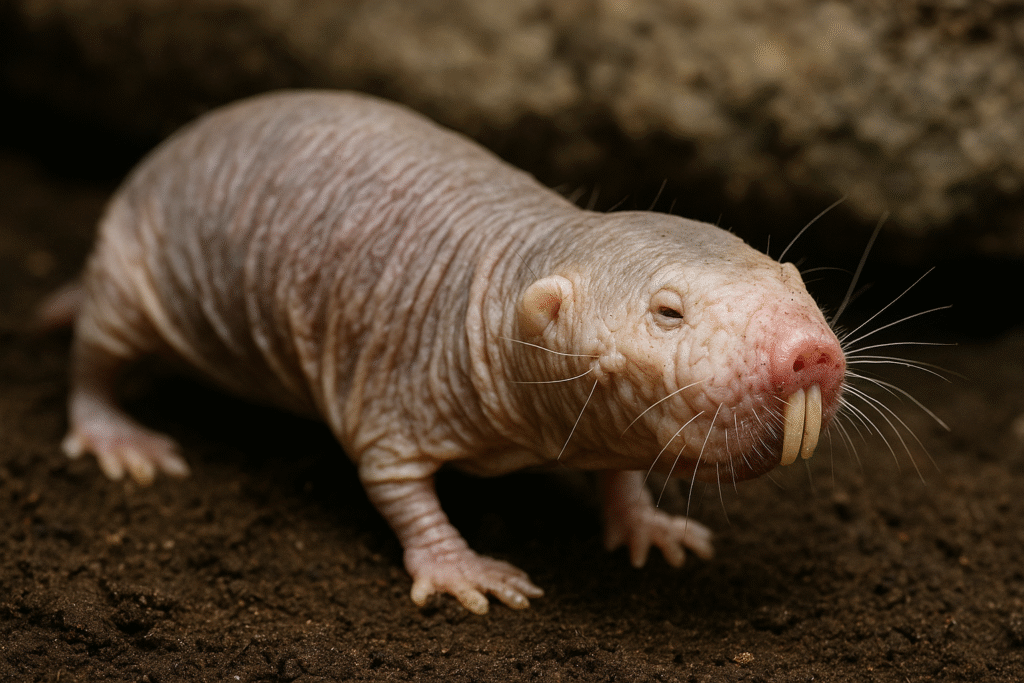By Harshit | 14 October 2025 | Shanghai, China | 11:00 CST
Naked mole rats, those unusual, bald, subterranean rodents that resemble sausages with teeth, have long fascinated scientists due to their remarkable lifespan and disease resistance. Now, a groundbreaking study sheds light on a genetic mechanism that may explain why these burrow-dwelling mammals live up to 40 years — the longest lifespan recorded for any rodent.
The new findings, published in Science, focus on DNA repair mechanisms that help naked mole rats maintain the integrity of their genetic material. While most rodents have relatively short lifespans, naked mole rats defy the usual biological expectations. They are resistant not only to cancer but also to neurodegenerative disorders such as brain and spinal cord deterioration, as well as age-related arthritis. Understanding their biology could offer crucial insights for human health and longevity research.
DNA Repair: The Key to Longevity
At the heart of the research is a protein known as c-GAS. In humans, c-GAS is involved in detecting DNA damage, but it can also interfere with the repair process, inadvertently promoting cellular aging and cancer development. However, in naked mole rats, the same protein behaves in a radically different way. Instead of hindering DNA repair, it actively facilitates the process, ensuring that damaged DNA strands are accurately mended using undamaged templates.
“This discovery is incredibly exciting,” said Professor Gabriel Balmus, a leading expert on DNA repair and aging at the University of Cambridge. “It’s really the tip of the iceberg in terms of understanding why naked mole rats live such extraordinarily long lives.”
The study suggests that over millions of years, naked mole rats have evolutionarily rewired their DNA repair pathways. The c-GAS protein in these rodents has subtle structural differences compared to humans, allowing it to promote repair rather than inhibit it. Prof. Balmus likens the process to a biological Lego piece: “The same basic structure exists in both humans and naked mole rats, but in the mole rat version, a few connectors are flipped, enabling an entirely different function.”
Implications for Human Aging
These findings raise compelling questions about the potential for translating naked mole rat biology to human health. Could reprogramming similar pathways in humans reduce age-related diseases and extend lifespan? While practical applications are likely years away, researchers are optimistic about the broader implications of the study.
“Imagine if we could reverse-engineer aspects of naked mole rat biology,” Prof. Balmus explained. “We might develop new therapies to protect against cancer, neurodegeneration, and other diseases associated with aging, improving both lifespan and quality of life.”
The study’s focus on DNA repair is part of a growing field investigating how cellular maintenance contributes to longevity. By understanding why certain species live far longer than expected, scientists hope to uncover mechanisms that can be leveraged in medicine. Naked mole rats now join other long-lived species, such as whales and bats, in offering clues about the evolutionary strategies that protect against aging.
Resilience in Harsh Environments
Part of the naked mole rat’s longevity may also be attributed to its subterranean lifestyle. Living in extensive tunnel networks shields them from predators and harsh environmental conditions, but their unique biology ensures survival even under extreme circumstances. The rodents have low metabolic rates, unusual pain insensitivity, and exceptional resistance to low oxygen levels. These traits, combined with their enhanced DNA repair, create a perfect storm for longevity.
Professor Balmus emphasizes that studying naked mole rats is not just about lifespan. “Their biology provides a window into how evolution can reprogram proteins to act in reverse,” he said. “Understanding these processes may reveal fundamental principles applicable to human aging and age-related diseases.”
Future Directions
The research team in Shanghai and collaborators worldwide are now investigating whether other proteins in naked mole rats exhibit similar rewiring and whether these mechanisms could be mimicked in human cells. While much remains to be discovered, this study marks a significant milestone in the quest to understand aging at a molecular level.
As scientists continue to unravel the secrets of these remarkable rodents, naked mole rats may hold the key to future breakthroughs in extending human healthspan and combating age-related illnesses. Their peculiar appearance, underground lifestyle, and extraordinary biology together make them one of nature’s most compelling models for longevity research.







